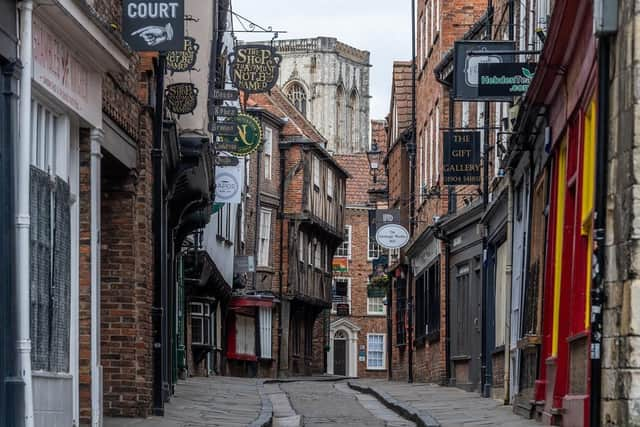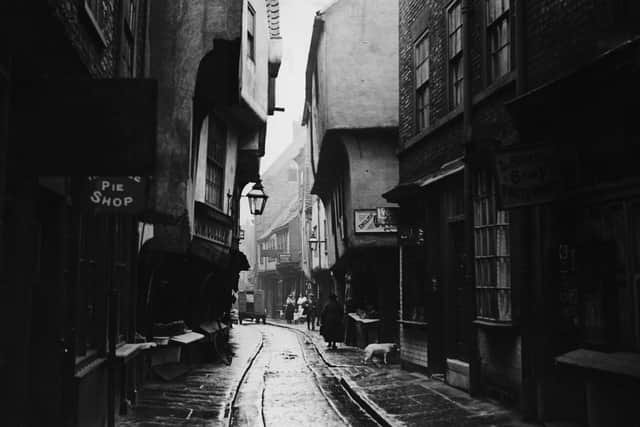Shambles, York: The rich history of one of Yorkshire’s most famous streets including its previous names in the 13th, 14th and 15th centuries
Shambles is a historic street in York and is considered to be one of the best preserved streets in England due to its mediaeval featured buildings, some dating back to the 14th century. It is narrow and has many timber-framed buildings with cobblestone streets.
Nearly all of the buildings on the street are listed including 1 Shambles, a 14th century building once William Brodie’s butchers, 7-8 Shambles, 15th century buildings and 12 Shambles, a building with some features dating back to the 14th century. At the end of the street is the parish room of St Crux.
Advertisement
Hide AdAdvertisement
Hide AdThe street was originally occupied by butchers since the 11th century, however, now it is populated with a variety of eateries, gift shops and souvenir shops and sweet shops. Due to its longstanding history, it has been the location for many ghost tours for people who love the supernatural world and is a major tourist attraction.


History of Shambles, York
Whilst the street has not been specifically referenced in the Domesday Book of 1086, butchers who worked at stalls close to St Crux church at the Shambles have been identified. The church was owned by the Count of Mortain, a Norman nobleman and the half-brother of King William the Conqueror.
The back of the shops were slaughterhouses and their positioning meant the meat displayed could stay fresh for longer periods of time as they were away from direct sunlight. At the time when butchering took place, the guts and blood were thrown onto the sloped street runnels, which helped wash it away by the rain.
The last of the butchers closed in the early 20th century due to the unhygienic practices and even though the butchers are no longer there, a number of their shops remain on the street and they still have meat hooks hanging outside. The shops include restaurants, a bookshop and a bakery.


Advertisement
Hide AdAdvertisement
Hide AdMany of the buildings at the Shambles have kept their original mediaeval built fabric with many buildings dating back from circa 1350 to 1475. It has been a major tourist attraction since the early 19th century.
However, following the Second World War, many city planners wanted to make major improvements to the buildings, which were in urgent need of renovation at that time. The York City Council bought many properties from private owners and during the 1950s they largely altered and rebuilt many buildings and demolished large sections of the area, including the whole of Little Shambles.
The five ‘snickelways’ that led off the Shambles as small alleyways in the backs of buildings, which were demolished in the 1950s. These now open out to a big open space with market stalls now known as Shambles Market; it was previously named Newgate Market and was renamed in 2015.
What other names has Shambles had before?


The term ‘shambles’ is a previously used word for an open-air slaughterhouse and meat market, some suggest that the word derives from the Anglo-Saxon word ‘Shammel’ which means shelves that shops used to display their wares.
Advertisement
Hide AdAdvertisement
Hide AdOthers suggest that by AD 971 ‘shamble’ meant a ‘bench for the sale of goods’ and by 1305, a ‘stall for the sale of meat’.
The process of naming the street after butcher stalls remained since the 14th century due to the association of the street with butchers and its vital historical significance and character.
The area around the Shambles was known as Marketshire into the 14th century and included the streets of the Shambles and Pavement.
The Shambles had many names; by 1240 it was known as Haymongergate, in 1394 it was called Nedlergate, both said to be references to other trades and crafts which took place in the street.
By 1426 it had commonly been named The Great Flesh Shambles and over time was shortened to its current name.
Comment Guidelines
National World encourages reader discussion on our stories. User feedback, insights and back-and-forth exchanges add a rich layer of context to reporting. Please review our Community Guidelines before commenting.
